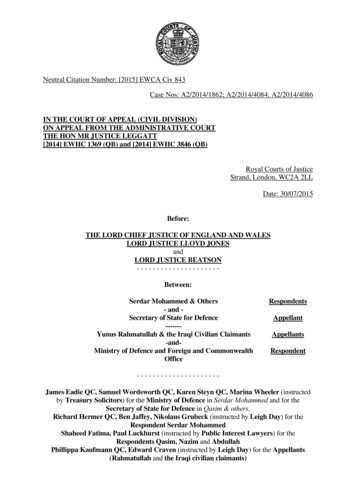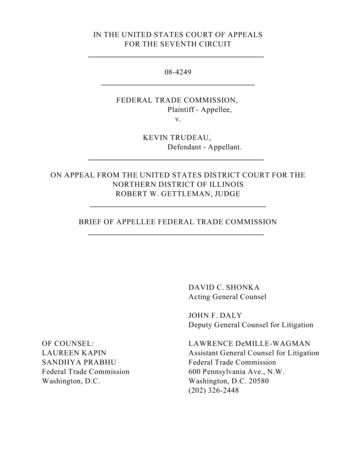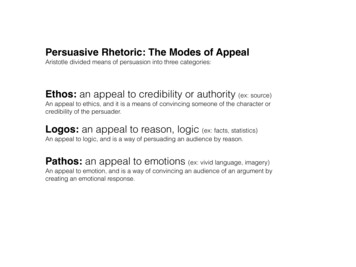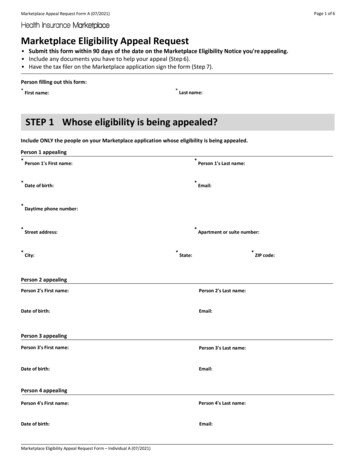
Transcription
MAINE SUPREME JUDICIAL COURTSITTING AS THE LAW COURTDocket No. Fra-17-12STATE OF MAINE,Appelleev.KEVIN O’DONNELL,AppellantOn Appeal from the Franklin County Unified Criminal DocketBRIEF OF AMICI CURIAE AMERICAN CIVIL LIBERTIES UNION OFMAINE, AMERICAN CIVIL LIBERTIES UNION, ELECTRONIC FRONTIERFOUNDATION, AND MAINE ASSOCIATION OF CRIMINAL DEFENSELAWYERSAugust 30, 2018Zachary L. Heiden (#9476)American Civil Liberties Union ofMaine Foundation121 Middle Street, Suite 200Portland, ME 04101(207) 619-8687Counsel for Amici CuriaeAdditional Counsel Listed on Following Page
Tina Heather Nadeau,Esq., Bar No. 4684Executive DirectorMaine Association ofCriminal DefenseLawyersP.O. Box 17642Portland, ME 04112-8642Counsel for AmicusCuriae Maine Associationof Criminal DefenseLawyersJennifer LynchElectronic FrontierFoundation815 Eddy StreetSan Francisco, CA 94109(415) 436-9333Of CounselNathan Freed WesslerJennifer Stisa GranickBrett Max KaufmanAmerican Civil LibertiesUnion Foundation125 Broad Street, 18th Fl.New York, NY 10004(212) 549-2500Of Counsel
TABLE OF CONTENTSTABLE OF AUTHORITIES . iiiSTATEMENT OF INTEREST. 1STATEMENT REGARDING ORAL ARGUMENT . 2STATEMENT OF THE CASE . 3STATEMENT OF ISSUES . 4SUMMARY OF ARGUMENT . 5ARGUMENT . 8I.Cellular Service Providers Are Able To Provide LawEnforcement With Precise and Voluminous Cell PhoneLocation Data. .8II.Acquisition of Real-Time Cell Phone Location Informationis a Fourth Amendment Search. .15A.The Third-Party Doctrine Does Not Apply to theLocation Data at Issue Here. .15B.The Warrantless Tracking of Mr. O’Donnell’s PhoneViolated His Reasonable Expectation of Privacy. .191.Real-Time Cell Phone Tracking RevealsPrivate Information About Presence inProtected Spaces. .202.Real-Time Cell Phone Tracking RevealsPrivate Information About Location andMovement Over Time. .233.Real-Time Cell Phone Tracking Provides theGovernment Unprecedented Powers ofSurveillance that Upset TraditionalExpectations of Privacy. .25C.The Warrantless Tracking of Mr. O’Donnell’s PhoneInterfered with the Security of His Person, Papers, andEffects. .28D.In the Absence of Exigent Circumstances, Real-TimeCell Phone Location Tracking Requires a Warrant. .33III. The Legislature Intended to Provide a Suppression Remedyfor Violations of 16 M.R.S. § 648.35CONCLUSION . 40CERTIFICATE OF SERVICE . 42CERTIFICATE OF SIGNATURE . .43ii
TABLE OF AUTHORITIESCasesCarpenter v. United States, 138 S. Ct. 2206 (2018) . passimCent. Bank of Denver, N.A. v. First Interstate Bank of Denver, N.A.,511 U.S. 164 (1994) .38Collins v. Virginia, 138 S. Ct. 1663 (2018) .29Commonwealth v. Almonor, No. 1283CR00492 (Plymouth Sup. Ct.Sept. 8, 2016), appeal pending, No. SJC-12499 (Mass.) .20Conroy v. Aniskoff, 507 U.S. 511 (1993) .39Florida v. Jardines, 569 U.S. 1 (2013) .29Ford Motor Co. v. Darling’s, 2016 ME 171 .35Grady v. North Carolina, 135 S. Ct. 1368 (2015) . 29, 30Hickson v. Vescom Corp., 2014 ME 27 .36In re Application for Pen Register & Trap/Trace Device with Cell SiteLocation Auth., 396 F. Supp. 2d 747 (S.D. Tex. 2005) .33In re Application of U.S. for an Order Authorizing Disclosure ofLocation Info. of a Specified Wireless Tel., 849 F. Supp. 2d 526 (D.Md. 2011). 12, 16, 17, 20In re Application of U.S. for Historical Cell Site Data, 724 F.3d 600(5th Cir. 2013). 17, 31Kyllo v. United States, 533 U.S. 27 (2001) . 6, 21, 22, 25Mahaney v. Miller’s, Inc., 669 A.2d 165 (Me. 1995) .38Maine Today Media, Inc. v. State, 2013 ME 100 .36McPheters v. Page, 83 Me. 234, 22 A. 101 (1891) .31iii
Milner v. Dep’t of Navy, 562 U.S. 562 (2011).39People v. Weaver, 909 N.E.2d 1195 (N.Y. 2009) .24Prince Jones v. United States, 168 A.3d 703 (D.C. 2017) . 27, 28Rakas v. Illinois, 439 U.S. 128 (1978) .31Riley v. California, 134 S. Ct. 2473 (2014) . 20, 26, 30See v. City of Seattle, 387 U.S. 541 (1967) .21Silverman v. United States, 365 U.S. 505 (1961) .31Skinner v. Ry. Labor Executives’ Ass’n, 489 U.S. 602 (1989) .17Smith v. Maryland, 442 U.S. 735 (1979) .18State v. Andrews, 134 A.3d 324 (Md. Ct. Spec. App. 2016) .22State v. Earls, 70 A.3d 630 (N.J. 2013) . 20, 22State v. Hutchinson, 2009 ME 44 .15State v. Oken, 569 A.2d 1218 (Me. 1990) . 22, 33Stone v. Bd. of Registration in Med., 503 A.2d 222 (Me. 1986) .39Stoner v. California, 376 U.S. 483 (1964) . 21, 22Tracey v. State, 152 So. 3d 504 (Fla. 2014). passimUnited States v. Jones, 565 U.S. 400 (2012) . passimUnited States v. Karo, 468 U.S. 705 (1984) .21United States v. Lambis, 197 F. Supp. 3d 606 (S.D.N.Y. 2016) .22United States v. Miller, 425 U.S. 435 (1976) .18United States v. Pineda-Moreno, 617 F.3d 1120 (9th Cir. 2010).10iv
United States v. Powell, 943 F. Supp. 2d 759 (E.D. Mich. 2013) .19United States v. Skinner, 690 F.3d 772 (6th Cir. 2012) .27Rules & Statutes12 R.I. Gen. Laws § 12-32-2.3212 R.I. Gen. Laws § 12-32-3.3816 M.R.S. § 647 .3516 M.R.S. § 648 . passim16 M.R.S. § 650 .416 M.R.S. § 650-A . 8, 37, 38, 4018 U.S.C. § 1039 . 33, 3818 U.S.C. § 3127 .3247 U.S.C. § 1002 .3247 U.S.C. § 222 .33725 Ill. Comp. Stat. 168/10 .32Cal. Penal Code § 1546.1 .32Ind. Code § 35-33-5-12 .32Kan. Stat. Ann. § 22-2502 .32M.R.S. § 650 .36M.R.U. Crim. P. 41B .37Md. Code Ann. Crim. Proc. § 1-203.1 .32Me. Const. art. IV, pt. 3, § 2 .39v
Minn. Stat. § 626A.42 .32Mont. Code Ann. § 46-5-110 .32N.H. Rev. Stat. Ann. § 644-A:2 .32Utah Code Ann. § 77-23c-102 .32Vt. Stat. Ann. tit. 13, § 8102 .32Other AuthoritiesDavid Schneider, New Indoor Navigation Technologies Work WhereGPS Can’t, IEEE Spectrum (Nov. 20, 2013) .9E911 Compliance FAQs, Verizon Wireless .10Fed. Bureau of Investigation, Domestic Investigations and OperationsGuide § 18.6.8.4.2.5.3 (2011) .7, 34In re Wireless E911 Location Accuracy Requirements, PS Docket No.07-114, Fourth Report and Order (F.C.C. Jan. 29, 2015).9Jamesa J. Drake, Reviving Maine’s State Constitutional ProtectionAgainst Unreasonable Searches and Seizures, 68 Me. L. Rev. 321(2016) .15Jari Syrjärinne & Lauri Wirola, Quantifying the Performance ofNavigation Systems and Standards for Assisted-GNSS,InsideGNSS (Sept./Oct. 2008) .11Matt Blaze, How Law Enforcement Tracks Cellular Phones,Exhaustive Search (Dec. 13, 2013).10Mobile Fact Sheet, Pew Research Center (Feb. 5, 2018) .14Report and Order and Further Notice of Proposed Rulemaking, In reRevision of the Comm’n’s Rules to Ensure Compatibility withEnhanced 911 Emergency Calling Sys., 11 FCC Rcd. 18676 (1996) .9Sprint, Sprint Corp. Transparency Report (2018) .14vi
Stephanie K. Pell & Christopher Soghoian, Can You See Me Now?:Toward Reasonable Standards for Law Enforcement Access toLocation Data That Congress Could Enact, 27 Berkeley Tech. L.J.117 (2012) .12The Electronic Communications Privacy Act (ECPA), Part 2:Geolocation Privacy & Surveillance: Hearing Before theSubcomm. on Crime, Terrorism, Homeland Sec. & Investigationsof the H. Comm. on the Judiciary 113th Cong. (2013) . 11, 12T-Mobile US, Inc., Transparency Report for 2017 (2018) .14Verizon, United States Report .14What is GPS?, Garmin .11vii
BRIEF OF AMICI CURIAE AMERICAN CIVIL LIBERTIES UNION OFMAINE, AMERICAN CIVIL LIBERTIES UNION, ELECTRONICFRONTIER FOUNDATION, AND MAINE ASSOCIATION OF CRIMINALDEFENSE LAYWERSSTATEMENT OF INTERESTThe American Civil Liberties Union (“ACLU”) is a nationwide, non-profit,non-partisan organization of nearly two million members dedicated to defendingthe civil liberties and civil rights guaranteed by the Constitution. The AmericanCivil Liberties Union of Maine (“ACLU of Maine”), founded in 1968, is the Mainestate affiliate of the ACLU. The ACLU and ACLU of Maine have a long history ofinvolvement, both as direct counsel and as amicus curiae, in cases involving theprotection of rights under the Fourth Amendment to the U.S. Constitution andarticle 1, section 5 of the Maine Constitution, including ensuring that those rightsremain robust in the face of evolving technology. The ACLU was counsel inCarpenter v. United States, 138 S. Ct. 2206 (2018), the case that prompted thisCourt’s call for amicus briefing here.The Electronic Frontier Foundation (“EFF”) is a member-supported, nonprofit civil liberties organization that has worked to protect free speech and privacyrights in the online and digital world for nearly 30 years. With more than 40,000active donors, including donors in Maine, EFF represents technology users’interests in court cases and broader policy debates. EFF served as amicus innumerous cases addressing Fourth Amendment protections for cell phone location1
information, including Carpenter v. United States, 138 S. Ct. 2206 (2018); In reApplication of U.S. for an Order Directing a Provider of Elec. Commc’n Serv. toDisclose Records to Gov’t, 620 F.3d 304 (3d Cir. 2010); In re Application of U.S.for Historical Cell Site Data, 724 F.3d 600 (5th Cir. 2013); Commonwealth v.Augustine, 4 N.E.3d 846 (Mass. 2014); United States v. Davis, 785 F.3d 498 (11thCir. 2015); In re Application for Tel. Info. Needed for a Criminal Investigation,119 F. Supp. 3d 1011 (N.D. Cal. 2015); United States v. Graham, 824 F.3d 421(4th Cir. 2016); and State v. Andrews, 134 A.3d 324 (Md. Ct. Spec. App. 2016).The Maine Association of Criminal Defense Lawyers is a statewideorganization of criminal defense attorneys dedicated to the fair administration ofcriminal justice throughout the State of Maine and the defense of all peopleaccused of crimes. MACDL has an interest in the present case, as its facts andissues are likely to arise in future cases impacting our member attorneys and theirclients.STATEMENT REGARDING ORAL ARGUMENTThe Court held oral argument in this case on October 12, 2017, prior to theU.S. Supreme Court’s decision in Carpenter v. United States. Amici respectfullysubmit that, in light of the Supreme Court’s clarification of Fourth Amendmentdoctrine, additional oral argument would aid this Court in its decision in this case.Should the Court decide to schedule additional argument, Amici respectfully seek2
leave to participate. Nathan Freed Wessler, undersigned attorney for amicusACLU, who argued Carpenter for the defendant-appellant before the SupremeCourt, and who has argued a number of cases involving cell phone locationtracking in state and federal appellate courts, would be pleased to participate inoral argument with leave of the Court.STATEMENT OF THE CASEWhile investigating a burglary of an unoccupied home in 2015 in whichDefendant–Appellant Kevin O’Donnell and a second individual, Danielle Nelson,were suspects, Sergeant Jared Austin of the Rangley Police Department directed adispatcher to submit emergency requests to Verizon to track and locateO’Donnell’s and Nelson’s cell phones in real time. (A. 60–61.) Police did notobtain a search warrant or other judicial authorization before submitting therequests. Sgt. Austin testified that Verizon assisted law enforcement by “ping[ing]”O’Donnell’s and Nelson’s phones, and transmitting their cell phone location databack to him. (A. 65.) The location data “showed both cell phones in closeproximity to one another . . . and [that] they were both in close proximity to twoseparate motels” in Lewiston. (A. 65.) Working with Sgt. Austin, Lewiston policesearched the area indicated by the cell phone location data, and located O’Donnelland Nelson at a Motel 6 in Lewiston. (A. 97–102.)3
Mr. O’Donnell filed a motion to suppress, arguing that the warrantlesstracking of his cell phone violated his rights under the Fourth Amendment, theMaine Constitution, and state and federal statutes. (A. 122–23.) The trial courtagreed with Mr. O’Donnell that there were no exigent circumstances that wouldjustify dispensing with the warrant requirement imposed by state law, 16 M.R.S.§§ 648, 650(4). (A. 26.) (The State does not contest this conclusion on appeal.(State’s Br. 10.)) The court denied suppression, however, on the grounds that “thewarrantless acquisition of cell phone location information from a third-partyservice provider does not constitute a search within the meaning of the FourthAmendment,” (A. 24), and that the legislature did not intend to create asuppression remedy for violations of the state statute requiring a warrant for cellphone location data, (A. 29).STATEMENT OF ISSUES1) Whether law enforcement’s acquisition of a person’s real-time cell phonelocation information from that person’s cellular service provider is asearch under the Fourth Amendment and article 1, section 5 of the MaineConstitution.2) Whether the proper remedy for violation of 16 M.R.S. § 648, whichrequires a warrant for law enforcement access to a person’s cell phonelocation information in the absence of a qualifying emergency, is4
suppression of evidence derived from the illegally obtained locationinformation.SUMMARY OF ARGUMENTFor the 95 percent of Americans who own cell phones, the technology hasbecome “such a pervasive and insistent part of daily life that carrying one isindispensable to participation in modern society.” Carpenter v. United States, 138S. Ct. 2206, 2220 (2018) (quotation marks and citation omitted). In this case, as inthousands each year, the government sought to exploit this essential technology byrequesting that a suspect’s cellular service provider track and locate the phone inreal time. Service providers can typically comply with such requests by sending asignal to the phone that surreptitiously enables its GPS chip and obtains thephone’s precise coordinates. Because people carry their phones with them virtuallyeverywhere they go, this capability effectively gives the government the power toinstantaneously install a tracking beacon on any person at any time. Unlessconstrained by the Fourth Amendment and article 1, section 5 of the MaineConstitution, that capability poses a grave threat to privacy and constitutes asweeping expansion of government power.In Carpenter, the Supreme Court held that the government’s warrantlessacquisition of a person’s historical cell phone location records infringes onreasonable expectations of privacy under the Fourth Amendment. In doing so, the5
Court rejected the government’s claim that the mere fact that the records are heldby the cellular service provider vitiates the cell phone user’s privacy interest underthe Fourth Amendment. Rather, because of the high sensitivity of cell phonelocation data and the unavoidability of its creation, the Fourth Amendment’sprotections apply. That rule applies squarely to the cell phone location data in thiscase.Moreover, as with the historical cell phone location records at issue inCarpenter, there is a reasonable expectation of privacy in the real-time cell phonetracking data in this case. Tracking a phone in real time can reveal a wealth ofinformation about patterns of activity that lays bare “familial, political,professional, religious, and sexual associations.” Carpenter, 138 S. Ct. at 2217(citation omitted). Because of the precision of the data, it can also reveal locationin homes, offices, hotel rooms, and other spaces that receive the highest protectionunder the Fourth Amendment, and for which warrantless searches using bothtraditional and technological means are forbidden. See Kyllo v. United States, 533U.S. 27, 40 (2001). At bottom, real-time cell phone tracking threatens toundermine the “degree of privacy against government that existed when the FourthAmendment was adopted,” Carpenter, 138 S. Ct. at 2214, because it gives police acapability unimaginable before the cell phone age—the power to pluck a person’sprecise location out of thin air. In order to prevent this capability from feeding a6
“too permeating police surveillance,” id. at 2214, the Fourth Amendment’s warrantrequirement applies. Of course, when law enforcement agents have probable causebut exigent circumstances prevent them from applying for a warrant, they mayproceed without one. Id. at 2222–23. But in a case like this, where no suchexigency existed, a warrant is required. That has been the rule followed by theFederal Bureau of Investigation for years,1 and this Court should make clear toMaine law enforcement that the Fourth Amendment requires it in stateinvestigations as well.Alternately, real-time cell phone location tracking is a search because itinterferes with an individual’s control over his or her person, papers, and effectswithin the meaning of the Fourth Amendment. By forcing a person’s cell phone totransmit its coordinates, the government reduces that person to a trackable object,converts the person’s cell phone into an active tracking device, andmisappropriates the person’s location data without consent. Because this trackingis incompatible with people’s rights to control use of their persons, papers, andeffects—i.e., their property rights—it constitutes a Fourth Amendment search. SeeCarpenter, 138 S. Ct. at 2268–69 (Gorsuch, J., dissenting); United States v. Jones,565 U.S. 400, 405 (2012).1See Fed. Bureau of Investigation, Domestic Investigations and Operations Guide§ 18.6.8.4.2.5.3, at 18-113–14 (2011), available estic-investigations-and-operations-guide.7
Finally, suppression is independently justified in this case because thegovernment violated Maine’s statutory requirement that, absent a qualifyingemergency, police can track a person’s cell phone only with a valid warrant. 16M.R.S. § 648. The Superior Court erred in relying on equivocal legislative historyto conclude that there was no suppression remedy for violations of the statute. Tothe contrary, the plain language of the statute provides that location informationand evidence derived from it may be used at trial only if a copy of the warrant isfurnished to the defense in advance. 16 M.R.S. § 650-A(1). Because thegovernment chose not to obtain a warrant in this case, it necessarily failed tocomply with this requirement and therefore was not entitled to the introduction ofinformation derived from the cell phone tracking.ARGUMENTI.Cellular Service Providers Are Able To Provide Law Enforcement WithPrecise and Voluminous Cell Phone Location Data.Because of capabilities built into cell phone networks and handsets inresponse to federal regulatory requirements, cellular service providers are able tolocate cell phones—and by extension the phones’ users—upon law enforcement’srequest. They can do so with enough precision to place a person within a specificroom of a home, even if they have no idea in advance who that person is or wherethey might be located.8
This capability stems from rules first adopted in 1996 and fully implementedby 2001, under which the Federal Communications Commission (FCC) requiredcellular service providers to have “the capability to identify the latitude andlongitude of a mobile unit making a 911 call.”2 The precision and accuracy of thismandated cell phone location capability is increasing. The FCC has adopted rulesto increase law enforcement’s ability to locate callers when they are indoors,3 andto require service providers to develop techniques to determine the altitude of thephone, and thus on which floor of a building it is located.4Although this capability was initially developed to assist in responding to911 calls, service providers now provide the same cell phone location informationto law enforcement pursuant to investigative requests. Rather than wait for thecustomer to initiate an emergency call, the service provider is able to connect to thecustomer’s phone and thereby determine its location. That is, law enforcement canask a wireless carrier to generate new, precise, real-time location data by acquiringinformation from the target’s phone. This can be done “on demand or at periodic2Report and Order and Further Notice of Proposed Rulemaking, In re Revision of theComm’n’s Rules to Ensure Compatibility with Enhanced 911 Emergency Calling Sys., 11 FCCRcd. 18676, 18683–84 (1996).3In re Wireless E911 Location Accuracy Requirements, PS Docket No. 07-114, FourthReport and Order at 1 (F.C.C. Jan. 29, 2015) (“Wireless E911 Order”), available athttps://apps.fcc.gov/edocs public/attachmatch/FCC-15-9A1.pdf; David Schneider, New IndoorNavigation Technologies Work Where GPS Can’t, IEEE Spectrum (Nov. 20, t.4Wireless E911 Order at 3-4.9
intervals.”5 As occurred in this case, some providers send location data to lawenforcement via email or similar means, (see A. 65), while other providers allowlaw enforcement “direct access to users’ location data” by logging into an“automated . . . web interface” provided by the carrier. United States v. PinedaMoreno, 617 F.3d 1120, 1125 (9th Cir. 2010) (Kozinski, C.J., dissenting fromdenial of rehearing en banc).The ability to locate and track a phone in real time has no relationship towhether the phone is actually in use. As long as a phone is connected to thenetwork, service providers can engage their location-tracking capabilities to find itat the request of law enforcement—a user cannot disable this functionality withoutturning the phone off or putting it into airplane mode (which, of course, renders thephone useless as a phone).6 Even disabling the location services setting on a smartphone cannot stop the carrier from determining the phone’s precise location in realtime: while the location privacy setting prevents third-party applications (“apps,”like Google Maps) from accessing the phone’s location information, it does notimpact the carrier’s ability to locate the device.Service providers can obtain the real-time location of a cell phone upon lawenforcement request in at least two ways, depending on the structure of the5Matt Blaze, How Law Enforcement Tracks Cellular Phones, Exhaustive Search (Dec. 13,2013), http://www.mattblaze.org/blog/celltapping/.6E.g. E911 Compliance FAQs, Verizon 11-compliance-faqs.10
carrier’s network: (1) by using hardware built into the phone (“handset-based”technology); and/or (2) by analyzing the phone’s interactions with the network’sbase stations, or “cell sites” (“network-based” technology).7Handset-based technology uses a mobile device’s “special hardware thatreceives signals from a constellation of global positioning satellites.”8 The GlobalPositioning System (“GPS”) chip installed in a cellular telephone uses radio signalsfrom GPS satellites orbiting Earth to calculate its own location within 10 meters.9Newer receivers, with enhanced communication to ground-based technologies thatcorrect signal errors, can identify location within three meters or closer, and have avertical accuracy of five meters or better 95 percent of the time.10Service providers do not typically maintain GPS coordinate records forphones using their networks, but, upon law enforcement request, they can remotelyactivate a phone’s GPS functionality and then cause the phone to transmit its7The Electronic Communications Privacy Act (ECPA), Part 2: Geolocation Privacy &Surveillance: Hearing Before the Subcomm. on Crime, Terrorism, Homeland Sec. &Investigations of the H. Comm. on the Judiciary 113th Cong. 6 (2013) (statement of Matt Blaze,Associate Professor, University of Pennsylvania) (“Blaze Hearing Statement”), available athttp://judiciary.house.gov/ .8Id. at 7; see also Wireless E911 Order at 5 n.11.9Blaze Hearing Statement at 7; see also In re Application of U.S. for an Order AuthorizingDisclosure of Location Info. of a Specified Wireless Tel. (hereinafter “Maryland Real-TimeOrder”), 849 F. Supp. 2d 526, 540–41 (D. Md. 2011) (noting that GPS -derived cell phonelocation data can be precise enough to locate a cell phone within a residence).10This is som
City of Seattle, 387 U.S. 541 (1967) . organization of criminal defense attorneys dedicated to the fair administration of criminal justice throughout the State of Maine and the defense of all people accused of crimes. MACDL has an interest in the present case, as its facts and











